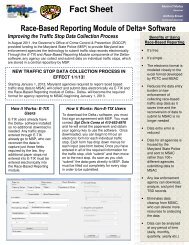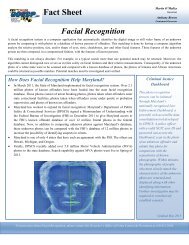Maryland Law Enforcement Improves Efficiency with Multidatabase ...
Maryland Law Enforcement Improves Efficiency with Multidatabase ...
Maryland Law Enforcement Improves Efficiency with Multidatabase ...
Create successful ePaper yourself
Turn your PDF publications into a flip-book with our unique Google optimized e-Paper software.
(From left) Kristen Mahoney, Gov. Martin<br />
O’Malley, Nathan Le and Ron Brothers worked<br />
together to implement the System z platform and<br />
DataDirect solution to quickly collect<br />
information from multiple databases.
Photography by Nicholas McIntosh<br />
The State of <strong>Maryland</strong> helps<br />
law enforcement agencies<br />
improve efficiency <strong>with</strong><br />
multidatabase access<br />
By Jim Utsler<br />
IBM Systems<br />
M A G A Z I N E<br />
IBM Systems<br />
M A G A Z I N E<br />
IBM Systems<br />
M A G A Z I N E<br />
Some say the only thing protecting society from<br />
free falling into chaos is the thin blue line—and<br />
IBM Systems<br />
they’re likely right. Without the dedication of had separate databases for its Division of Corrections, Division<br />
blue-uniformed local and state police officers, order of Parole, State Police Gun Registry and Sex Offender Registry;<br />
might crumble—forcing law-abiding citizens to each acted as a distinct and isolated data repository.<br />
M A G A Z I N E<br />
triple lock their doors and keep loaded shotguns at Realizing this hampered the capability of the state’s lawenforcement<br />
activities, <strong>Maryland</strong> Gov. Martin O’Malley directed<br />
their bedsides.<br />
IBM Systems<br />
Of course, these crime busters don’t work alone. Behind the officials to create a single view of people’s criminal backgrounds.<br />
scenes is a host of support personnel ranging from dispatchers, As part of this effort, they deployed a business-intelligence<br />
crime-scene analysts and senior officials. Together, they make (BI) tool from Oracle and a data-gathering tool from DataDirect<br />
M A G A Z I N E<br />
the streets safe for average citizens, allowing them to go about Technologies to create what users call the <strong>Law</strong> <strong>Enforcement</strong><br />
their business <strong>with</strong> little fear.<br />
Dashboard, and the governor calls “security integration.”<br />
Many people don’t consider IT’s role in law enforcement. The Now, statewide law-enforcement personnel and agencies can<br />
days of filing cabinets and boxes stuffed <strong>with</strong> paperwork are view pertinent data across databases, <strong>with</strong>out logging onto<br />
largely over, replaced <strong>with</strong> electronically held fingerprints, mug multiple systems.<br />
shots and criminal histories. This move to digital has made the<br />
thin blue line much thicker.<br />
Arrests and Convictions<br />
This transition hasn’t always been easy. Finding the right The collaboration of two State of <strong>Maryland</strong> organizations—the<br />
solutions and tying them together can be a chore. There aren’t Governor’s Office of Crime Control and Prevention (GOCCP)<br />
many applications tailored to the criminal justice industry, and and the Department of Public Safety and Correctional<br />
the appropriate solutions are often cobbled together based on the Services (DPSCS)—made this project possible. Using many<br />
needs of individual entities.<br />
funding sources, strategic planning, crime-data analysis and<br />
As a result, information related to the safety and protection of best-practices research, the GOCCP supports the education,<br />
officers and law-enforcement activities is typically held in siloed connections and empowerment of <strong>Maryland</strong>’s citizens and<br />
databases. The State of <strong>Maryland</strong> was one such organization. It public-safety organizations.<br />
JANUARY/FEBRUARY 2009 ibmsystemsmag.com/mainframe 17<br />
This article is posted <strong>with</strong> permission from IBM Systems Magazine, Mainframe edition.
UP<br />
Working <strong>with</strong> GOCCP, the DPSCS’s overarching mission<br />
is to help keep individual communities safer and provide<br />
victim services. It also supplies law-enforcement agencies<br />
<strong>with</strong> current access to accurate information about criminal<br />
defendants and offenders—as well as ensuring the safety,<br />
security and well being of these individuals while they’re under the<br />
organization’s supervision.<br />
Ron Brothers, CIO of the DPSCS’s Information Technology and<br />
Communications Division, explains the DPSCS runs Baltimore’s<br />
City Jail, City Detention Center and Pretrial Services. In addition,<br />
the division runs those facilities’ booking operations, as well as<br />
the booking processes for seven other counties. It also houses<br />
and maintains the Criminal Justice Information System, which<br />
acts as a repository for all of <strong>Maryland</strong>’s criminal histories.<br />
This last, data-related part is key, because the DPSCS shares<br />
that data <strong>with</strong> the GOCCP and other agencies to help them<br />
analyze crime data and make better-informed decisions. “We’re<br />
almost joined at the hip,” Brothers adds. Much of this data-related<br />
activity goes back to the day when <strong>Maryland</strong>’s Gov. O’Malley<br />
was the mayor of Baltimore.<br />
At that time, “the majority of people we were arresting for<br />
first-degree murder were under the supervision of the city’s<br />
Parole and Probation Department,” says GOCCP Director Kristin<br />
Mahoney, who used to work for the Baltimore Police Department.<br />
“We felt there was something lacking in the business practices of<br />
Parole and Probation, and that they could have more of a positive<br />
impact if we redesigned some of those business processes.”<br />
This information drove then-mayor O’Malley to direct the<br />
State’s Division of Parole and Probation to develop real-life<br />
risk criteria, in an attempt to identify <strong>Maryland</strong>’s most violent<br />
offenders as part of parole or probation. Previously, the division<br />
evaluated these people almost solely on convictions. But as<br />
Mahoney points out, “Some of these criminals may have been<br />
arrested 22 times before a conviction. As they continued to beat<br />
charges in court, offenders were able to fly under Parole and<br />
Probation’s radar, the organization responsible for ensuring they<br />
didn’t engage in illegal behavior. So arrests were an important<br />
part of establishing our risk criteria.”<br />
As a result of this effort, the <strong>Maryland</strong> Division of Parole and<br />
Probation was able to identify the state’s 2,000 most violent<br />
offenders who were on parole or probation. That knowledge,<br />
as well as other information, enabled local law enforcement to<br />
dramatically reduce the Baltimore City and Baltimore County<br />
murder rates.<br />
Abbreviated Code<br />
When O’Malley was elected governor, he took his crimefighting<br />
philosophy <strong>with</strong> him to the capitol in Annapolis. Now,<br />
the governor had more on his mind; he had an entire state to<br />
manage. He felt a new, higher-level view of statewide crime<br />
control strategy should be developed. As was the<br />
case <strong>with</strong> the Parole and Probation Department,<br />
not enough information was being shared, largely<br />
because applications and data warehouses were<br />
siloed based on purpose and platform.<br />
Some applications ran on IBM AIX* technologybased<br />
servers, others on PC servers, yet more <strong>with</strong>in IBM<br />
BladeCenter* servers and several others on an IBM<br />
System z* 890. That mainframe, according to Brothers,<br />
hosts “a parole and probation case-management system and the<br />
Division of Corrections case-management system. Additionally,<br />
criminal history is still housed on the mainframe.”<br />
This diffusion of data made it difficult to access and aggregate<br />
information, <strong>with</strong> users logging into multiple systems to get the<br />
information they needed. “You need to know what a murder<br />
suspect looks like, what his criminal history is, what his gang<br />
affiliations might be, before you go out to serve a warrant,”<br />
Mahoney says. “Otherwise, you’re putting your law-enforcement<br />
professionals in potential personal peril.”<br />
However, few law-enforcement personnel had the patience to<br />
wade through the systems that held important information. If they<br />
wanted a photo, they’d have to tap into the state’s DMV or booking<br />
system. If they wanted a criminal history, they’d have to dive into<br />
the mainframe. If they wanted information about gang affiliations,<br />
they’d have to go into the Department of Corrections system.<br />
To make matters worse, many of the applications were greenscreen<br />
based. As a result, function keys were used to find the<br />
needed information. If users hit the wrong key, they’d have<br />
to find a way to back out of that system to find the right one.<br />
Even after they found the correct information, much of it was<br />
displayed as abbreviated code, which meant users guessed what<br />
it meant. These and other issues, including multiple login IDs and<br />
passwords, meant users didn’t tap into the full potential of the<br />
information available.<br />
Parole and Probation<br />
To rectify this problem, the GOCCP worked <strong>with</strong> the DPSCS to find<br />
a solution that allowed officers to access information contained<br />
in many relevant databases on a single page, using one login ID<br />
and password. The question remained: how best to do it. Not only<br />
would they have to deliver the data, but they’d also have to ensure<br />
it was consistent.<br />
In March 2007, CIOs from various <strong>Maryland</strong> law-enforcement<br />
agencies gathered to review their requirements. According to<br />
Mahoney, “This was the first time they’d ever seen each other,<br />
representatives from the information-management departments<br />
from all 149 police departments in <strong>Maryland</strong>.” Fortunately,<br />
most wanted the same data available to their officers, including<br />
photographs and information about gun ownership, protective<br />
orders, and parole and probation status.<br />
18 JANUARY/FEBRUARY 2009 ibmsystemsmag.com/mainframe
CLOSE<br />
CUSTOMER: State of <strong>Maryland</strong> Governor’s<br />
Office of Crime Control and Prevention<br />
and Department of Public Safety and<br />
Correctional Services<br />
HEADQUARTERS: Towson, Md.<br />
BUSINESS: <strong>Law</strong> enforcement<br />
HARDWARE: IBM System z 890<br />
SOFTWARE: DataDirect Shadow from<br />
DataDirect Technologies and Oracle Business<br />
Intelligence Enterprise Edition from Oracle<br />
CHALLENGE: Dealing <strong>with</strong> multiple databases<br />
on multiple platforms<br />
SOLUTION: Using the DataDirect solution to run<br />
queries against the mainframe system and the<br />
Oracle solution to gather and disseminate<br />
information from all databases<br />
Once parameters were defined, Brothers and Nathan Le,<br />
DPSCS manager of business systems, got to work. “Once we gave<br />
them the challenge, they just took off and applied all of their<br />
resources, brains and energy to help, like they were just sitting<br />
there waiting for someone to knock on their door to ask them<br />
what value they could bring to crime fighting,” Mahoney says.<br />
Brothers and Le (who Mahoney affectionately refers to as “mad<br />
scientists”) were waiting for just such a directive. They knew the<br />
databases were siloed and of limited use. They also knew they<br />
had the go-ahead and the budget to solve the problem. What<br />
they didn’t want to do, however, was to write individual query<br />
programs to call each of the databases.<br />
“Because each database was siloed and different, we would<br />
either have to become experts in each database type, or go to the<br />
programmers from each data center to do much of the work for<br />
us. We didn’t feel like either alternative was feasible or effective,”<br />
Brothers says.<br />
Instead, the DPSCS searched for a tool that would do the<br />
mining for them, negating the need to write query programs.<br />
After an intensive search and a lengthy proof of concept, they<br />
decided to use the Oracle Business Intelligence Enterprise Edition<br />
to provide a BI platform and Web portal.<br />
“What we were looking for was a solution that could touch a<br />
multitude of different databases <strong>with</strong>out requiring any back-end<br />
modifications on our part,” Brothers recalls. “The Oracle tool<br />
provided that. Then Nathan became the final key to the problem.<br />
He became a consummate expert on what this tool could do and<br />
has solved problems that Oracle said couldn’t be solved.”<br />
Drivers and Queries<br />
The only sticking point was the database on the z890; the<br />
Oracle tool didn’t integrate <strong>with</strong> the IBM IMS* and Virtual<br />
Storage Access Method (VSAM) as well as Brothers and Le had<br />
expected. So they began looking for a middleware-type tool that<br />
would allow the information contained in IMS and VSAM to be<br />
presented to the end user, via the Oracle portal.<br />
DataDirect Shadow from DataDirect Technologies was the<br />
solution. Once they realized it would work <strong>with</strong> the Oracle BI<br />
tool, they began using DataDirect Shadow beyond the mainframe.<br />
Using this solution, Brothers and Le created hooks to<br />
IMS and VSAM using an industry-standard ODBC driver, which<br />
translates Web portal requests into the appropriate IMS and<br />
VSAM database-query format. According to Le, “The Oracle BI<br />
tool allows us to get to any database that’s ODBC compliant or<br />
has ODBC drivers. The DataDirect solution provides that driver<br />
for IMS and VSAM, so we can go out and touch them through<br />
the Oracle BI tool. All of the underlying mapping is transparent<br />
to the developer, who simply codes standard SQL calls.”<br />
Now the organization doesn’t have to write a program to<br />
tap into IMS and VSAM, or to create another back-end, ODBCcompliant<br />
intermediate database–both of which would slow<br />
response times. Similarly, using DataDirect Shadow, there’s<br />
no need for a load and transfer process, which allows the data<br />
to pop up alongside the information from other databases.<br />
“The latency is very low, and we’re very happy <strong>with</strong> the<br />
performance,” Le adds.<br />
Previous response times for each queried database averaged<br />
upwards of six minutes. Now, the combined DataDirect/Oracle<br />
solution is in place, those times have dropped by around 90<br />
percent, even though query results are coming from across all<br />
of the databases. Brothers couldn’t be more pleased <strong>with</strong> the help<br />
he and Le received from DataDirect. “They really partnered <strong>with</strong><br />
us to make sure this solution would work for us,” Brothers says.<br />
Security Integration<br />
Phase one of the solution went live in August 2008, and the<br />
GOOCP is now in the process of training its 15,048 informationauthorized<br />
law-enforcement personnel on system use and is<br />
requesting feedback for future refinement.<br />
The <strong>Law</strong> <strong>Enforcement</strong> Dashboard can be accessed via many<br />
standard Web browsers, including mobile data terminals<br />
outfitted in many patrol cars. Officers now have easy access to<br />
all the information they need when dealing <strong>with</strong> people on the<br />
street. When searching for a person’s name they’re presented<br />
<strong>with</strong> photos, arrest records, convictions and parole and probation<br />
information.<br />
This “security integration” tool, as Gov. O’Malley calls it, is<br />
poised to dramatically change the way law-enforcement officers<br />
work both in the field and at their desks, making that thin blue<br />
line a bit wider.<br />
Jim Utsler, IBM Systems Magazine senior writer,<br />
has been covering the technology field for more<br />
than a decade. Jim can be reached at jutsler@<br />
msptechmedia.com.<br />
JANUARY/FEBRUARY 2009 ibmsystemsmag.com/mainframe 19

















